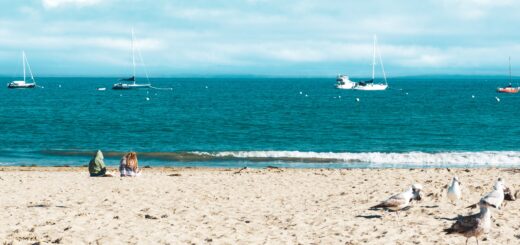A Morning in the Intertidal
Today’s low tide arrives not too long after sunrise, leaving parts of the beach still in shadows. The tall, beige, silty cliff that backs the beach blocks the easterly sun. Typical summer morning fog floats on the horizon over the open water. Within an hour or two the fog will lift as the sun continues to rise. It won’t return again until the evening.
The Approach
To get to the “secret” tunnel, I pick my way across the rocky benches exposed by the tide. Tidepools of various depths still hold water and will shelter intertidal species until the water returns with high tide.
Long blades of kelp lie limp across the rocks and sand. Without water they have no way to stand upright. Patches of bright green surfgrass, the only true plant in the intertidal, break up the brown and grey monotony of the rocks and algae.
As I near the headland, the sound of waves breaking and crashing on the shore accompanies the crunch of my footsteps in the coarse sand.

Adventure Awaits
The tunnel, and beach beyond it, are only accessible at very low tide. But be prepared to get wet. Even when the tide is out, you have to walk through hip deep water to make it all the way through.
Plop, plop, plop. Water drips from the cliff face as I splash through an incoming wave to enter the tunnel. The low ceiling makes the tunnel dark and shadowy. And the air is humid.
The tunnel walls are covered with black California mussels. Their blue tinged shells cluster tightly together. Gooseneck barnacles have wedged themselves between the mussels. Groups of small roundish sea snails occupy free spaces around the mussels and barnacles.
Deep inside the cliff, the tunnel makes a sharp left turn. Here is where an adventurous spirit comes in handy. The sandy beach and ocean are visible on the other side of the tunnel, but the deepest pools are between me and them.
Tighten the backpack straps. Secure the phone and sunglasses. Don’t step on any critters as you wade through the slightly warmer water. On far side of tunnel, I emerge onto a small pocket beach. A glance back reveals the tunnel doesn’t look like a tunnel at all from this angle!

On the Beach
More rocky benches and elevated sea stacks bracket the beach. They are covered with life. Green, brown, pink, and red. Soft and squishy looking, hard and immovable. Bands of species clearly mark the different water levels on the side of the rocks.
I yelp as a sneaker wave sends cold water over my head and down my back. Bits of sand and shell stick to my arms and face. Water spots the view through my sunglasses.
If you look in cracks, crevices, and pools, colorful life awaits. Purple Pacific sea urchins tuck themselves into holes almost hidden from view. But a cluster of blunt purple spines poking out around algae give them away. Orange and deep purple ochre stars cling to the vertical sides of the rocky platforms. Their bumpy bodies stay moist from waves splashing even at low tide. If you venture further out where there’s still deeper water, you might find leather sea stars with smooth, mottled grey, blue, and orange skin.


Named for the bold stripes of blue, green, or yellow on their round oral disc, sunburst anemones wave spotted tentacles in the water. But get too close and they quickly pull in those tentacles and close up their bodies as a defense strategy.
Don’t stay here too long. The incoming tide will very quickly make passage back through the tunnel treacherous. And there’s still many tidepools, caves, and sandy beach areas to explore on the way back to the car.
Note: I’m taking a News and Feature Writing class at UCSD, and wrote this for a homework assignment. It’s inspired by a recent “working” meeting with one of my grad students at the beach. We chatted about her thesis writing while she showed me the little known tunnel and beach you read about here.



